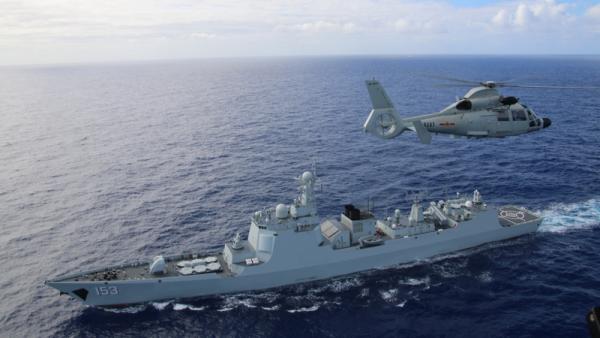Sun Hongjie / Wikimedia Commons

James Laurenceson, Director, Australia-China Relations Institute, University of Technology Sydney |

Chengxin Pan, Adjunct Associate Professor, Australia-China Relations Institute, University of Technology Sydney |
This article appeared in the Australian Institute of International Affairs’ blog, Australian Outlook, on October 15 2021.
When Scott Morrison, Boris Johnson, and Joe Biden jointly announced the creation of the AUKUS alignment nearly a month ago, China wasn’t mentioned. But the Australian high commissioner to New Delhi, Barry O’Farrell, told the Indian media that the decision to acquire nuclear-powered submarines, a central element of the AUKUS deal, was the result of ‘an unprecedented military build-up by China.’ Many commentators agree, arguing that Beijing has only itself to blame for AUKUS.
Yet in a recent episode of the Australia in the World podcast, Allan Gyngell asks a sharp question that demands a plain response from such AUKUS advocates: what level of Chinese military spending would they consider ‘permissible’?
The fact is that the absolute value of China’s military spending only stands out because its economy has become much bigger than any other in the region. SIPRI estimates that China’s military spending now stands at 1.7 percent of GDP. This is slightly down from 1.9 percent in 2009, much less than the US (3.7 percent), and significantly less than Korea (2.8 percent), Vietnam (2.4 percent), and India (2.9 percent). In Australia, the figure is 2.1 percent.
Of course, threat assessments in Canberra, Washington, and London are not only informed by China’s aggregate spending. Specific capabilities being pursued by Beijing matter, such as its expanding inventory of aircraft carriers, ballistic missile submarines, and other ‘area denial’ assets. Specific behaviours matter too, such as its widely reported ramping up of ‘sabre-rattling’ towards Taiwan. Still, the fundamental build-up or expansion that China had engaged in is an audacity to successfully grow its economy, which until recently has been hailed largely as an opportunity.
One way of bringing China’s military spending to a ‘permissible’ level would be to contain its economy and, as US Commerce Secretary Gina Raimondo put it, to ‘slow down China’s rate of innovation.’ Yet presumably all but the most extreme commentators would accept that the Chinese people have a right to aspire to the same living standards as those in high-income, liberal democracies.
Of course, Beijing could have capped the absolute value of military spending to allay any regional fears that its expanding economic stature was not being translated into military power. But putting this into context, if the level of military spending in 2012 was maintained – the year President Xi Jinping came to power – data from SIPRI and China’s national income accounts imply that it would now be worth just one percent of GDP, and soon head even further south. This is the same proportion that Japan spends with its US-imposed pacifist constitution and an explicit US security guarantee.
Is it reasonable to expect that China’s population would see this as acceptable given the external environment it faces? After all, the 2017 US Strategic Framework for the Indo-Pacific began by listing the first national security challenge as being ‘how to maintain US strategic primacy in the…region.’ It finished with a desired end state as being one where the US ‘maintains diplomatic, economic, and military pre-eminence.’
Prominent Australian national security commentators, such as the ANU’s Rory Medcalf, remarked that the document brought ’authoritative clarity to the public record.’ The clarity it brought was a stated US intention to keep China subordinate in its own region. If the US hasn’t sought other countries’ permission to spend more than the next 11 countries combined, then should anyone expect China to stay within a ‘permissible’ limit set by the US and its allies, who have never shied away from pursuing a balance of power in the region in their favour?
Some might argue that the US and its allies were compelled to respond to China’s own muscular behaviour, such as its island building in the South China Sea from 2014. But the chronology is more jumbled.
Even leaving aside the Obama administration’s ‘pivot to Asia’ announced in Canberra almost ten years ago, following the AUKUS announcement columnist Peter Hartcher explained to readers that, ‘for many years, a critical element of American war planning has been to defeat China’s navy by bottling it up in the shallow waters of the South China Sea.’ Or in more florid prose, ‘It’s easier to shoot fish in a barrel than in a pond.’
For the US, the submarines that Australia was proposing to buy would ‘block choke-points that allow [China] passage in and out.’ This articulation of US plans – to keep China ‘hemmed in’ – was backed by Medcalf. Hartcher then conceded that this was why China has ‘put so much effort’ into expanding its capacity to assert control over its near seas. To borrow Tony Abbott’s phrase at a recent forum in Taiwan, ‘no self-respecting country could accept‘ such a prospect without putting up a fight.
So, when many accept at face value that AUKUS is a justified response to China’s ‘massive’ military build-up and ‘aggressive’ behaviour, they fail to acknowledge China’s legitimate economic achievements and future hopes, let alone its legitimate security fears (such as Beijing’s longstanding concern about its ‘Malacca Dilemma’). That failure may well come home to roost in short order, long before Australia’s nuclear-power submarine fleet sees the light of day or starts shooting fish in a barrel in the South China Sea.
If feeling cornered with no other options, China could quickly ramp up its military spending. The value of its economy in 2020 was US$14.7 trillion. Going from spending 1.7 percent of GDP to Australia’s middling 2.1 percent implies an annual increase of $60 billion. This is more than double the total value of Australia’s annual military spending, according to SIPRI.
Worryingly but perhaps not surprisingly, the answer to the potentially escalating arms race offered by Scott Morrison and Peter Dutton is even more Australian military spending. If this comes to pass, the result will not be a region in which Taiwan, Australia, or anyone else is safer or more prosperous, with the possible exception of weapons makers well-represented at a recent defence sector roundtable in Washington.
Authors
Professor James Laurenceson is Director of the Australia-China Relations Institute at the University of Technology Sydney.
Chengxin Pan is Associate Professor of International Relations at Deakin University and Adjunct Associate Professor at the Australia-China Relations Institute at the University of Technology Sydney.


